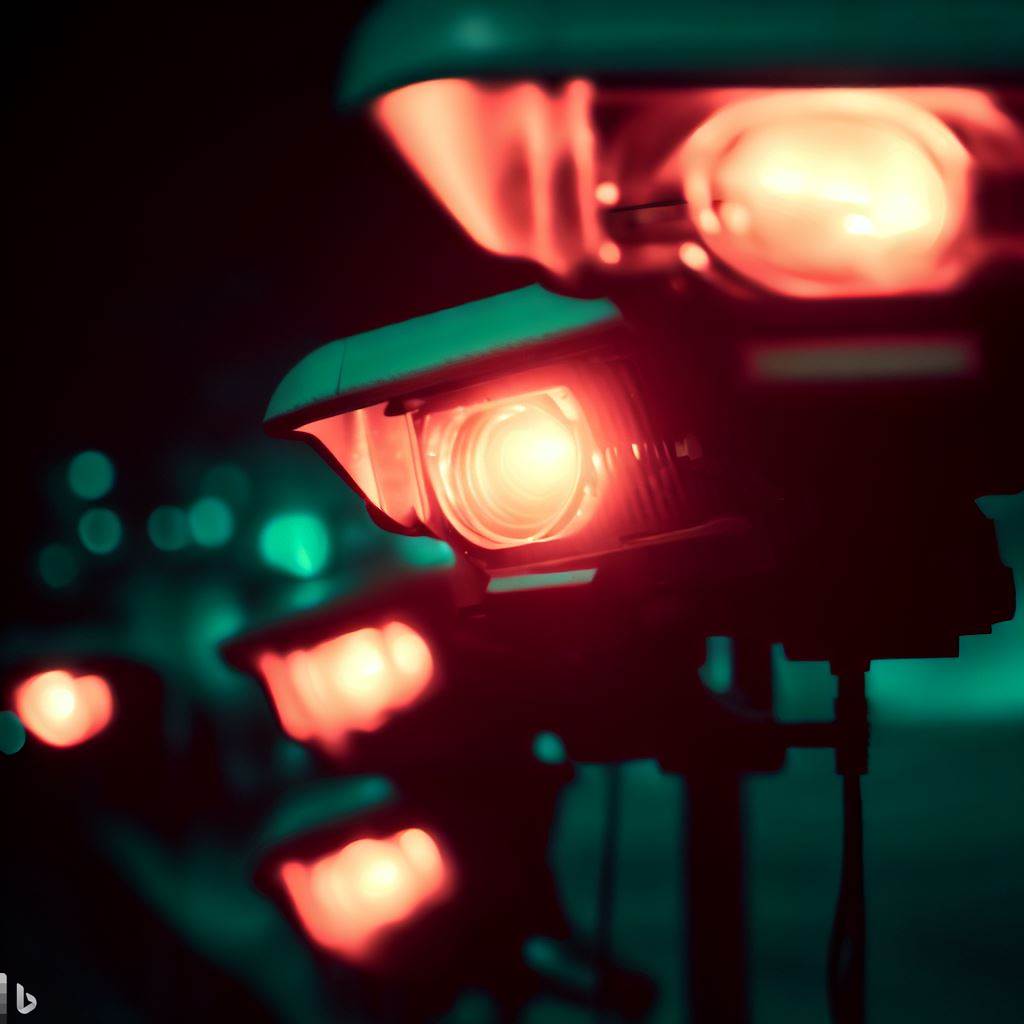

Infrared illuminators play a crucial role in enhancing night vision capabilities, allowing us to see clearly in low light or complete darkness. By emitting infrared light that is invisible to the naked eye, these illuminators enable night vision devices to capture images and videos with crisp detail and clarity.
Whether it’s for surveillance, wildlife observation, or even paranormal investigations, understanding the role of infrared illuminators is essential for unlocking the hidden world of the night.
Understanding Infrared Illuminators
Infrared illuminators play a crucial role in enhancing night vision capabilities by providing an additional source of invisible light. This light is outside the range of human vision but can be detected by specialized devices like night vision goggles or cameras.
By utilizing the power of infrared light, these illuminators enable users to see clearly in low-light or complete darkness situations. They serve as essential tools for various applications, including military operations, surveillance, security systems, and wildlife observation.
Definition and Function
Infrared illuminators are devices that emit infrared light, which is a longer wavelength than visible light. They function by illuminating the surrounding area with infrared light, making objects more visible to night vision devices. By doing so, they enhance the detection range, improve visibility, and facilitate the capturing of clear images and videos in challenging lighting conditions.
Types of Infrared Illuminators
There are different types of infrared illuminators available in the market, each with its own characteristics and applications. The most common types include LED-based illuminators, laser illuminators, and thermal illuminators.
LED-based illuminators are popular due to their energy efficiency, long lifespan, and affordability. They emit infrared light through an array of LEDs, which can be either single or multiple units. Laser illuminators, on the other hand, use laser diodes to emit a highly focused beam of infrared light. They are often utilized in long-range applications, such as military operations or border surveillance. Lastly, thermal illuminators use thermal imaging technology to detect and amplify heat signatures, providing a clearer picture in complete darkness.
How Infrared Illuminators Work
To understand how infrared illuminators work, it is essential to grasp the concept of the infrared light spectrum and the underlying technology.
Infrared Light Spectrum
The infrared light spectrum consists of wavelengths longer than those of visible light. It is divided into three categories: near-infrared (NIR), mid-infrared (MIR), and far-infrared (FIR). Near-infrared consists of wavelengths between 700 to 1400 nanometers (nm), while mid-infrared ranges from 1400 to 3000 nm. Far-infrared covers the range from 3000 to 1 millimeter (mm).
Infrared illuminators primarily emit light in the near-infrared spectrum, which is most commonly used for night vision applications.
IR Illumination Technology
Infrared illuminators harness various technologies to emit infrared light. The most prevalent technology is based on light-emitting diodes (LEDs). These LEDs are specifically designed to emit near-infrared light, making them a popular choice for illuminators.
Another technology used is laser diodes. Laser illuminators produce a highly concentrated beam of infrared light with excellent range and intensity.
Passive vs. Active Illumination
Infrared illuminators can be categorized into two types: passive and active. Passive illuminators work by utilizing the existing infrared light present in the environment. They do not emit their own light but instead enhance the detection range by intensifying the available infrared light.
In contrast, active illuminators emit their own infrared light, providing an additional source of illumination in complete darkness. Active illuminators are more commonly used in scenarios where there is little to no ambient infrared light present.
Advantages of Infrared Illuminators in Night Vision
The use of infrared illuminators in night vision provides several significant advantages, making them an integral part of any night vision system.
Enhanced Visibility in Low Light
One of the primary advantages of infrared illuminators is their ability to improve visibility in low-light conditions. By emitting infrared light, these illuminators effectively illuminate the surrounding area, making objects more visible to night vision devices.
This enhanced visibility allows users to navigate, identify targets, and capture images or videos with increased clarity, even in complete darkness.
Extended Range of Detection
Infrared illuminators significantly extend the range of detection for night vision devices. By emitting infrared light, they provide a source of illumination for the devices to capture and process.
This extended range allows users to detect objects, individuals, or potential threats from a greater distance, improving situational awareness and safety in low-light environments.
Minimal Power Consumption
Infrared illuminators are designed to be energy efficient, ensuring prolonged use without excessive power consumption. This is especially beneficial for portable night vision devices such as goggles or handheld cameras, as it allows users to operate the devices for extended periods without the need for frequent battery changes or recharging.
Considerations When Using Infrared Illuminators
While infrared illuminators offer numerous advantages, there are several considerations to keep in mind when using them for night vision applications.
Potential Hazards
It is important to be aware of the potential hazards associated with infrared illuminators. Although the emitted infrared light is invisible to the human eye, it can still be harmful if exposed directly to the eyes. Therefore, it is crucial to avoid looking directly into the illuminator or shining it towards people or animals.
Importance of Proper Alignment
Proper alignment of the infrared illuminator is essential for optimal performance. The direction and angle at which the illuminator is aimed can significantly affect the range and coverage area. It is crucial to align the illuminator correctly with the night vision device to ensure the desired results.
Factors Affecting Performance
Various factors can impact the performance of infrared illuminators. The range of the illuminator, measured in meters or feet, determines how far the emitted light can effectively reach. The power output, measured in watts or milliwatts, affects the intensity and coverage area of the infrared light.
Additionally, external factors such as weather conditions, terrain, and the reflective properties of the objects in the environment can also impact the overall performance of the illuminator.
Applications of Infrared Illuminators
The versatility of infrared illuminators allows them to be utilized in a wide range of applications across different industries and sectors.
Military and Law Enforcement
Infrared illuminators are extensively used by military and law enforcement agencies for various purposes. They help in nighttime surveillance, tactical operations, and target acquisition. These illuminators enable personnel to navigate and identify potential threats in low-light or complete darkness, providing a significant advantage in critical operations.
Surveillance and Security Systems
Infrared illuminators play a crucial role in surveillance and security systems, particularly in areas requiring continuous monitoring. They enhance the effectiveness of security cameras by providing additional illumination in areas with poor lighting conditions. This improves the quality of video footage, making the identification and recognition of people or objects easier.
Wildlife Observation and Photography
Infrared illuminators are valuable tools for wildlife observation and photography enthusiasts. They allow for the capture of clear images and videos of nocturnal animals without disturbing their natural behavior. Wildlife researchers and photographers can document species that are active during the night, providing valuable insights into their behaviors and habitats.
Choosing the Right Infrared Illuminator
Selecting the appropriate infrared illuminator is crucial to achieve optimal results in night vision applications. Consider the following factors when choosing an illuminator:
Factors to Consider
- Range: Determine the desired range of detection and select an illuminator that matches or exceeds that range.
- Power Output: Consider the power output of the illuminator to ensure it provides sufficient intensity and coverage for the desired application.
- Mounting Options: Evaluate the available mounting options and compatibility with the night vision device to ensure proper alignment and integration.
- Mode of Operation: Some illuminators offer different operating modes, such as continuous, strobe, or adjustable power. Choose one that suits the specific requirements of the application.
Matching Illuminator to Night Vision Device
It is essential to match the infrared illuminator to the specific night vision device being used. Factors such as compatibility, mounting options, and power requirements should be considered to ensure seamless integration and optimal performance of both the illuminator and the night vision device.
Maintenance and Care of Infrared Illuminators
Proper maintenance and care of infrared illuminators are essential to ensure longevity and optimal performance.
Cleaning and Protection
Regular cleaning of the illuminator’s lens and body is crucial to remove any dirt, dust, or debris that may accumulate over time. It is important to use cleaning materials and techniques recommended by the manufacturer to avoid damaging the device. Additionally, protecting the illuminator from extreme weather conditions and impacts can help prolong its lifespan.
Storage and Handling
When not in use, it is advisable to store the infrared illuminator in a dry and secure place. Properly handling the device, avoiding excessive force, and following any specific instructions provided by the manufacturer are essential to prevent damage or malfunction.
Future Developments in Infrared Illuminators
As technology continues to advance, the future of infrared illuminators looks promising. Several developments are expected to shape the industry.
Advancements in Technology
Advancements in LED and laser diode technologies are expected to result in more efficient and powerful infrared illuminators. These improvements will likely lead to increased range, improved image quality, and enhanced energy efficiency.
Additionally, advancements in thermal imaging technology may lead to the development of more effective thermal illuminators, further improving night vision capabilities.
Increasing Availability and Affordability
As technology becomes more accessible and production processes become more efficient, the availability and affordability of infrared illuminators are expected to improve.
This will enable a wider range of users, including outdoor enthusiasts, hobbyists, and professionals, to benefit from the enhanced night vision capabilities provided by these devices.
Conclusion
Infrared illuminators are essential components in the field of night vision technology. By emitting infrared light, they enhance visibility, extend detection range, and enable clear imaging in low-light or complete darkness.
From military and law enforcement operations to surveillance systems and wildlife observation, infrared illuminators have a wide range of applications.
It is crucial to consider factors such as hazard precautions, alignment, and performance when using these illuminators. By choosing the right illuminator and properly maintaining it, users can maximize their night vision capabilities.
With future advancements on the horizon, the role of infrared illuminators in night vision is set to become even more significant.
Top Night Vision Goggles of 2023: Expert Reviews and Buying Advice
The Ultimate Guide to the Top 5 Night Vision Binoculars for Hunting
Top 5 Night Vision Monoculars for Hunting in 2023 | Best Rating
GOSKY BAK4 Angled Night Vision Scope Review for Hunters
How Do I Minimize Noise When Using Night Vision For Hunting?




